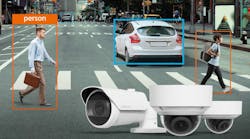Among the heaviest burdens of today’s Chief Security Officer is owning the responsibility for the vast and growing scope of risk facing their organization. From liability for on-site incidents to maintenance of compliance standards on the factory floor, the range of potential issues continues to expand along with the CSO’s need for answers.
We can all pinpoint the shift in attitude towards security to a Tuesday morning in 2001 – a day after which it became very clear that many of our fundamental perceptions about how to conduct business would have to change. Since that day, the pace of new technology development in the security field has accelerated exponentially, along with our expectations for protection of people, property and assets. In the last few years, we have also seen the growth in importance of a C-level title for security – the CSO or Chief Security Officer. While adding security to the C-suite demonstrates an organization’s commitment to safety, it also designates a specific individual who holds the ultimate responsibility for anything that might go wrong across the myriad facets of an organization.
Since 9/11 the paradigm of professional security has changed. The Internet and the growth of IP-based networked security systems have given us access to reams of data, generated by a widening range of advanced technologies for situational awareness, risk management, event response and communications. This reliance on data is certain to continue growing as we look to security systems for more information to which we can apply sophisticated analytics and data processing risk management algorithms.
A significant share of this data is generated in the form of video. Video surveillance has gained tremendous penetration in literally every type of organization and facility all around the globe, and surveillance cameras are virtually always in sight wherever you go. Video is constantly being transmitted, recorded, watched, archived and analyzed, and data from video surveillance systems has become critically essential for identifying criminals, gaining insights into events and protecting organizations from liability.
For the CSO, owner of all risk within the organization, the importance of video cannot be overstated. Two minutes of recorded video can save a corporation millions of dollars in a lawsuit, or keep executives safe from prosecution or incarceration in a criminal investigation. Real-time video can help pinpoint the location of an active shooter and help to save many lives. Sophisticated analytics can identify an individual trying to breach the perimeter of a critical infrastructure facility and send an alert to an administrator, prompting quick response to keep large segments of population safe from a wide range of terrorist threats. In all of these situations, it is easy to recognize the disastrous consequences that would ensue if at the critical moment, when the video was most needed, for whatever reason the display screen was simply blank.
Missing video is a risk that CSOs simply cannot take. The most common modalities to maintain video systems – spot-checking, scheduled maintenance and environmental monitoring systems – cannot ensure that video will always be available and there will never be a missing segment. Further, as networks continue to grow in complexity it is becoming increasingly difficult to afford even those limited resources. Remote locations and small sites only add to the complexity. At times, even when all components appear to be working properly there can still be moments when the video stream is interrupted – a condition that is no longer tolerable.
The same accelerating research and development movement that is driving new security technologies across myriad platforms is, fortunately, also delivering a host of new solutions to secure the security systems – a sort of meta-security that is building traction as overall integrated systems become more complex. For CSOs who carry the risk of the entire organization on their shoulders, these solutions are quickly proving their ROI by helping to maintain a higher level of protection and safety from threats and their consequences.
In the realm of video surveillance, this solution takes the form of automated software that can collect thousands of diagnostic inputs on an ongoing basis, correlate all the data and perform predictive analytics to identify potential issues that could affect the video stream before they become problems. Without ever touching video content, the software analyzes the video stream and alert essential personnel to any pending issues – along with the tools to address and repair the issue and keep the video stream flowing. The solution is easy to implement, cost efficient and conveniently manageable from users’ mobile devices.
Keeping an organization free from missing video is no longer optional for today’s CSO. There is far too much at stake, and video has become far too important in the overall architecture of the security system, to take that kind of risk. With new technology available that can eliminate missing video, the day will soon come when CSOs can shift focus away from those concerns and reduce the organization’s exposure to risk.
About the Author:
Bud Broomhead is the CEO of Viakoo. Viakoo is an industrial IoT company with a focus on critical infrastructure, specifically managing collections of devices that work together to accomplish a given task.


